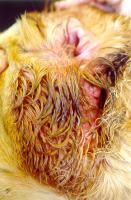Hot Spots are one of many skin irritations seen in pets. Often, you’ll hear your veterinarian refer to them as moist pyoderma. They occur when your dog itches, scratches or licks him or herself excessively, eventually forming a wet scab on the fur. But what do you with a hot spot?
Hot Spots can seemingly appear spontaneously anywhere on a dog’s body. This moist, raw skin disorder has a variety of causes but the most consistent factor is inflammation.
Anything that irritates or breaks the skin can create the environment for bacterial contamination in the deeper layers of the skin. Such incidences of moisture can be such seemingly innocuous things such as as a recent bath, swim, stroll in the rain, or playtime in wet craze. Even a slightly oozing sore can provide enough moisture for a bacterial infection to take hold.
Although there are various types of “hot spot”-causing bacteria, most respond to oral and topical antibiotics. Cats rarely acquire hot spots.
How to treat a Hot Spot
1. Trim the area around the hot spot with animal clippers. If the area is too big, shave it. Exposing it to air will dry out the moisture and help speed healing. Some of the more serious hot spots are too painful to clip with your pet awake, and may require light anesthesia.
2. Clean the area with a mild antibacterial shampoo and pat dry.
3. Apply an antiinflammatory spray or cream (with a veterinarian’s prescription) to stop the itching and help promote healing. Some hot spots are so serious that oral or injectable steroids will be necessary to reduce the inflammation.
4. Prevent your dog from biting, licking or scratching the affected area by placing an Elizabethan collar (plastic cone) around your dog’s neck.
5. Keep an eye on the area to make sure it continues to heal and doesn’t worsen or spread. Hot spots usually require a visit to the veterinarian.
Hot Spots, Moist Pyoderma, and Summer Sores
Here are a few more things you might not have known about hot spots. They seem much more prevalent in the summer months. They can cause severe itching and self-trauma because the infection goes into the deep layers of the skin. This is why they may take two weeks or more to finally look like they are healing.
Keep your dog well groomed, especially in hot seasons. Any dog that has matted, dirty hair coat is at greater risk of developing hot spots. Many owners will have their long or thick-furred dog shaved closely in the summer. This really does help prevent the thick coat from covering any dampness on the surface of the skin. If the fur is allowed to accumulate too much moisture, the wet skin underneath can become the perfect breeding ground for bacterial growth and hot spots.
And though they mostly occur in the summertime, hot spots can develop at any time. If your dog develop a skin lesion, call your veterinarian immediately. Do not delay! You may run the risk that your dog’s condition deterioates quickly (see below).
This Golden Retriever developed a hot spot under each ear and this severe moist eczema developed in less than 24 hours! Both ears and both sides of the dog’s face needed to be clipped and cleaned while under light anesthesia.

